Goture Seeker Hard Carbon Herabuna Rod Hand Fishing Rod 3.6m 4.5m 5.4m 6.3m 7.2m Carp Fishing Pole Trout Tenkara Fly Fishing Rod
$37.49$55.8933% off
This deal will end in
length: 3.6 m

Goture Seeker Fishing Rod Carbon Fiber 3.6m 4.5m 5.4m 6.3m 7.2m Hard Stream TelescopicFishing Rod Carp Fishing Pole 2/8 Power
Feature:
Material: Carbon Fiber
Size:3.6M/4.5M/5.4M/6.3M/7.2M
Top Dia: 0.9mm
Butt Dia:12mm/14mm/17mm/18.5mm/19.5mm
Section: 7/8/10/11/12
Power:2:8
Rod Weight: 105g/132g/210g/249g/299g
Line Weight: 1.5kgs
Suitable for: Stream, River, Lake, Reservoir Pond
Target Fishes: Carp Fish, Bream, Tilapia and other freshwater fishes
Seeker Rod Feature:
1.24T carbon fiber fiber blanks for light and sensitivity
Package including:
01. For all rods, we will send top three extra tips!

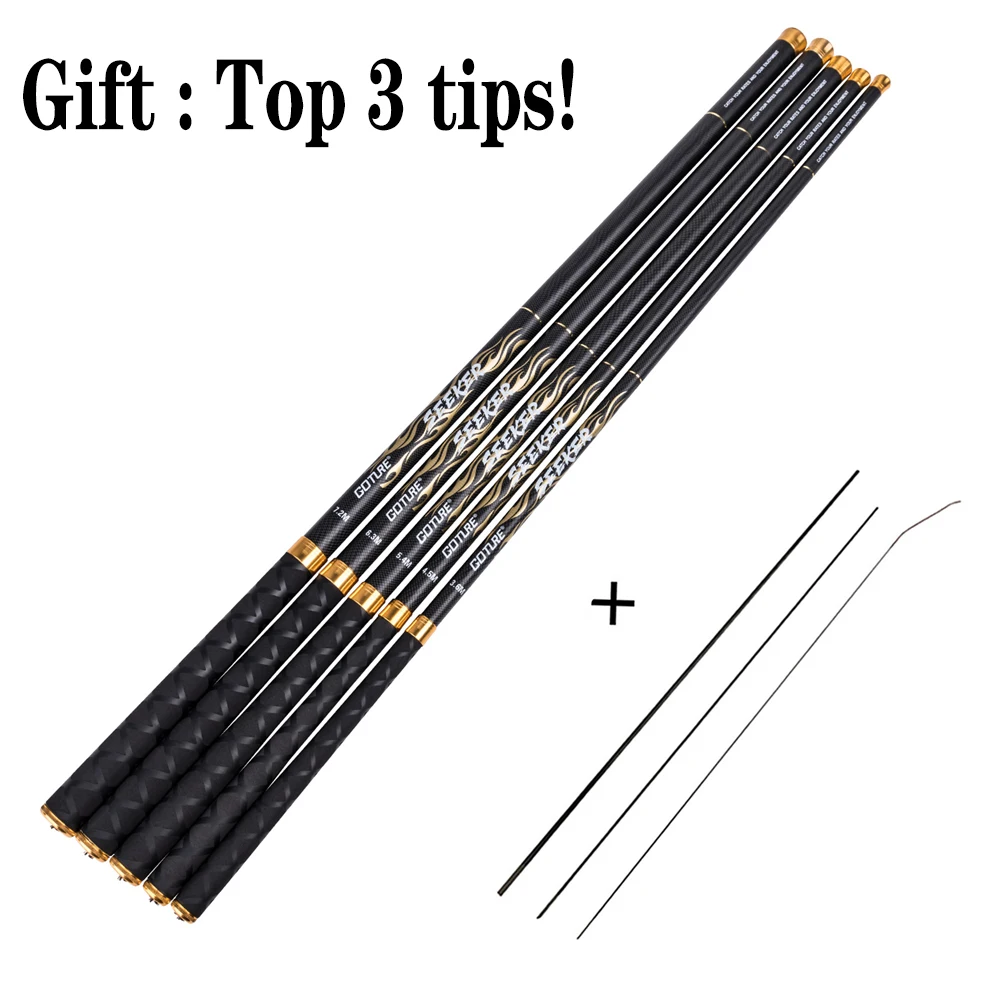
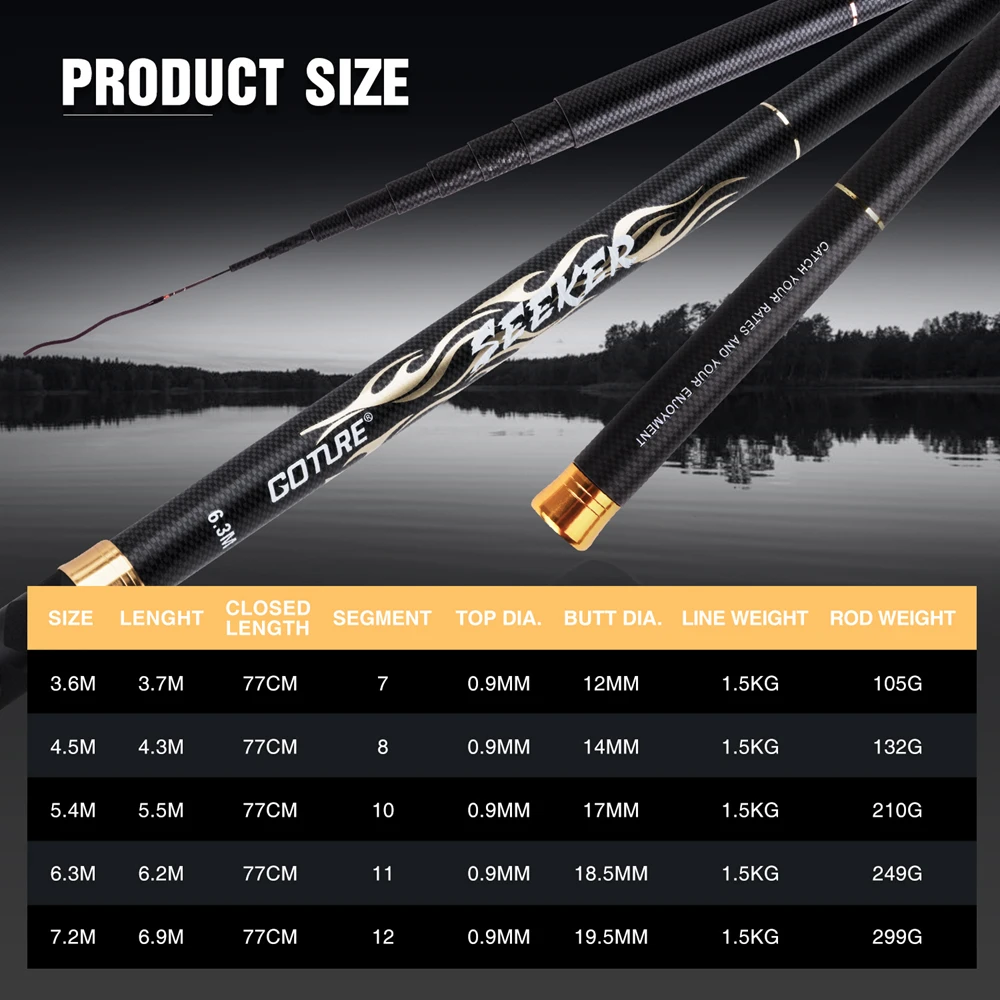


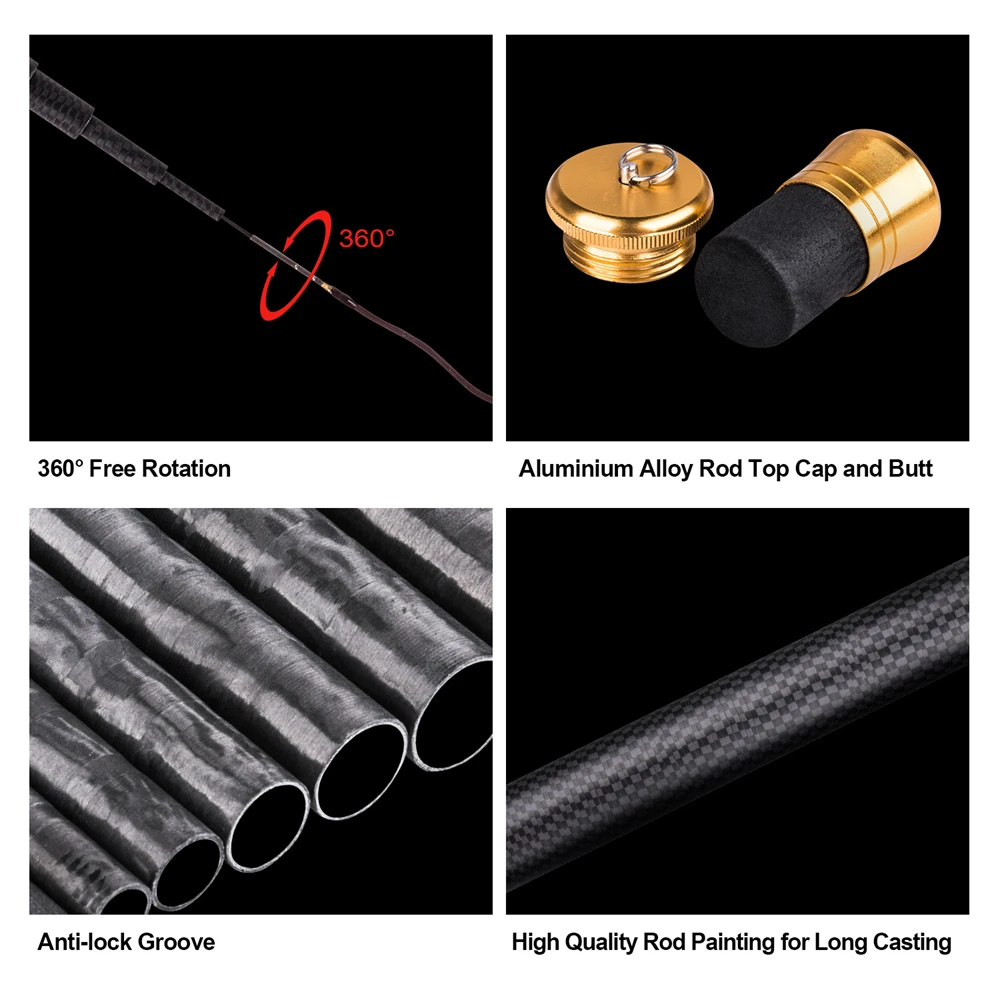


How to use Goture Seeker Fishing Rod?
The quality of the fishing rod you hold and the line you use are the two things that affect your sense of feel. The rod blank and action determine the amount of vibration that travels from the bait up through the line to the hand. Performance and comfort are extremely important. A quality rod is worth the price and using nice rod will increase your fishing success. It is always better to purchase one best quality fishing rod instead of using the same amount of money to buy several cheaper rods.
These telescopic fishing poles of the highest quality are lightweight and incredibly strong, thanks to a High Modulus Graphite Carbon manufactured in Japan, using Japanese Design, Engineering and Technology. We all know that when design and engineering are concerned the Japanese technology is still the best in the world by far. Special low resin high tension graphite on the blank are added for an outstanding power. Extra Cross wave enchancement graphite lays on the surface of joint added for the security. Accurate weight calculation of each section builds this a good balance fighting match.
Very Light Weight allows fishing all day without arm fatigue, to be able to concentrate ground baits in very small areas of water and be able to fish outside, over or above of your feed area with the utmost accuracy. Flexibility and Extra Fast, Fast or Medium Action makes these poles perfect for casting light float rigs; It allows you to see the most delicate fish bites. Power helps you actually fight the big fighter. Length allows to get you deep into the brush where large fish hide, It allows to get the live baits or spoons in hard to reach places where reel rod can't.
Catching big fish on the pole is very challenging. You can land realy big one and the advantages in skilful bait presentation are outstanding. Pole fishing can be used to catch almost all fish, they are excellent for Bass fishing or Crappie fishing using live bait on a lake, great for Trout fishing with a dry fly on a streams or rivers, Carp fishing using corn or worms on a pond, snapper (baby bluefish) on the shore or Striped Bass on a bay.
Pole Fishing is an art form. Poles provide a level of precision that a rod with reel just can't produce. You can't even imagine the fun you got when gently move the pole against the fish to strike, ship the line to you, swing the fish to hand, unhook, re-bait and place pole back in the water ready for the next fish. Just once you try pole fishing, you'll ask yourself why it wasn't sooner.
Simplicity of a pole fishing
Poles are big, long and taper to a fine tip ended with strong Braid Lilian String connected to the tip. This string greatly enhances the sensitivity of the pole for detecting slightest strikes. Pole is designed to use without a reel. The line of a float rig can be attached to this lilian string with a single overhand loop, tied onto the pole tip. This braid material is greatly enhances the sensitivity of the rod that allows the detection of the slightest most delicate bites and smother casting of light float rigs.

Several helpful Tips
Never lift your catch, always play with the fish and use landing net to land it. Always extend and insert telescopic sections very gently, try do not extend them too forcibly, try to keep it off the ground to avoid dirt getting into the joints. Wipe it clean with a cloth before taking it down so you don't jam dirt into the joint, rinse pole with freshwater after using it in saltwater as soon as you can. Always remember to take a good care of your poles and they will work for you for a very long time and will bring you large amount of catches and a huge amount of great emotions. More great emotions - longer and healthier is your life.
How to Attach the line to a Fishing Pole?
1. A single overhand loop on the braid lilian material connected to the pole's tip is all you need.
2. Next make a double knot on the fishing line.
3. After that put the loop over the braid lilian between the pole tip and the single overhand loop and tide the line.


It can also be set up to attach the pole to the piece of elastic, placed inside the pole tip sections. The elastic is used to assist in fighting fish. Using elastic in the pole tip allows the fish to fight against something. It also helps to keep a tight line between the fish and pole tip. It can also protect the pole and float rig when the fish surges away. You can find more information in more details about elasticating fishing pole on How to elasticate a fishing pole page.
How to attach line with Haris using a swivel.

To prevent "Interwined" use smaller swivel. Tie guiding line with swivel by clind knot or uni knot. Then set haris. It is always better to use hook connected with haris first. You need to change the haris constantly to get a better result.
How to attach float to the line
Rubber float stopper, "pipe stopper" is used to keep a float with a guiding line. Every rubber stopper has a certain size that fit with the line.

2. While holding the line with your finger, slide the rubber pipe up the line.
3. Slide the pipe up the line.
4. Attach the free moving float cap in between the two pipe stoppers. Make 2cm gap between the two stoppers.
5. Attach the float by sliding tightly the float stem to the free moving float cap. Slowly tighten.
How to adjust float, weights and line?
One of the most important and very first things to do is to work out the water depth and adjust your weights and line to get the float sitting right. The line should be adjusted according to the way the fish are feeding.
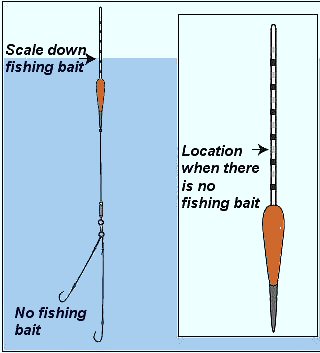


2. Add sufficient weight (depth measure) so that roughly the bottom area of the float's pole sinks below the water. Adjust the bait mark on the float, the point where the water comes up. When the bait mark shows up above the water means there is no more bait on the hook.
3. Attach some weight to the hook and cast into the water. The float should sinks below the water.
4. Removing some amount of the weight repeatedly cast the float into the water and slowly bringing the float higher until the float bristle just sticks out of the water.
5. Once the float is adjusted properly remove the weight (depth measure); it will leave your hook just sitting on the bottom.
Later while fishing if the bait isn't sitting properly on the bottom and you are only getting nibbles and not any good bites on the line it is good idea to adjust your rig by increasing the length of the line below the float by about 1 cm at a time. Keep doing it until your catch rate and strike rate are increased.

How to roll sinker around the line

1. Winding tissue paper or cotton thread around fixed part of the weight.
2. Crease with a scissor. The width of the crease is around 1.0mm - 1.5mm.
3. Put guiding fish line in the fold.
4. Fold it closely by your thumb to the roll up tightly and to make "Tune Circle". If you do not fold it closely enough it would be flat shape.
5. Roll it on a flat surface. If it looks "Flat", roll it on flat surface with pushing of hand hood. It helps to shape up.
How to attach swivel to the line and tie on the leader.
Double back and make 5-6 turns around the line.
Pass the end of the line through the first loop, above the eye, and then through the large loop. Draw the knot into shape.
Slide the coils down tight against the eye.
2. Cut extra line.

How to Cast Telescopic Carbon Pole Rod?
Telescopic flexible rods made of Graphite Carbon are extremely sensitive and must be handled with extra care. They could not be overloaded; casting should be done when sections are fully open but without using a force. No sideway pressure should be applied. You should also always keep the rod's power rating in mind and never use fishing line or bait that's too heavy, that can also lead to an unexpected breakage. They usually don't break while fighting the fish but they could break while casting if a wrong load is used or if too much pressure is applied to collapse the sections of the rods.
Casting of telescopic pole whip is very easy. There are 2 types of cast: under arm cast and overhead cast.
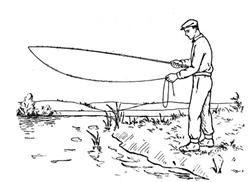

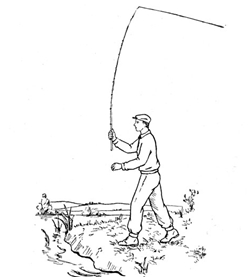
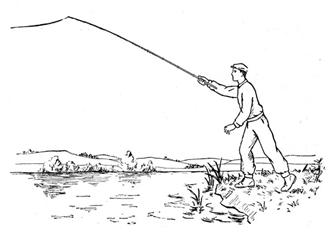
How to fish with a pole.
There are many varieties of poles available. They come in different lengths, strengths and designs. Poles provide a tremendously wide variety of fishing, using a fly, live bait or worm. They can be used to fish shallow or fast rivers, to small ponds or large lakes. The control that it gives you over your float tackle is superb. They can be used to 'bag-up' on small fish like Roach, good fighters Largemouth Bass and jumping Trout or to tame the hard fighting Carp. Poles allow you to fish with a great level of precision and sensitivity. It is a very popular technique with match fishermen, and when used in the hands of a professional, can result in a huge weight of fish. It really is something you have to see and try to believe.
There are a few different techniques that can be used to fish with a pole.

- After throwing the bait put the rod so that it will be comfortable quickly take it with your right hand. It is not recommend using more than two fishing poles at the same time. Excess fishing line can scare big fish, it can become entangled in fishing lines from other poles; a large number of floats are scattered your attention, and you may miss the most important bait.

- Dabbling involves "dabbling baits" next to stumps, riverbanks, holes in moss beds and other tight spots. In these situations, a pole allows bait to be presented and retrieved over structure a rod and reel could not reach without fouling. This technique can be used with a variety of artificial lures and natural baits and with or without a bobber.
- Sling-shot In order to get a bait or lure under overhead structure like docks or limbs, hold hook by the bend, pull back to put tension on pole and release. The lure is "shot" ahead in whatever direction the pole is aimed. This technique is best performed with artificial lures.
- Strolling is basically manual trolling along a bank that is free from obstructions. To do so, simply walk along water's edge with pole extending at a right angle over the water. Be sure to extend the pole in or out to work around structure as you pass. This can be done with a variety of natural baits and artificial lures.
- After setting the rods, you just need relax, sit and watch the floats. When you will see the movements of the float, which means that the fish touches the bait, put your hand on the rod, and closely follow the further movements of the float. Features baits, time of strikes and time of setting the hook when fishing with a float depend on many factors: kind of species, if the fish hungry, what kind of baits you are using, if tackle is noticeable or invisible - etc.
